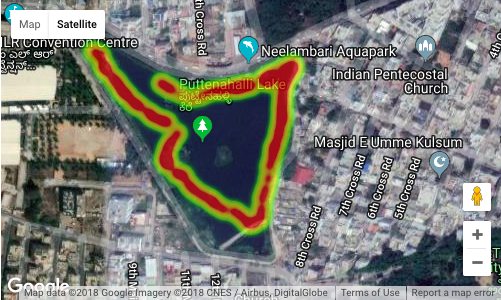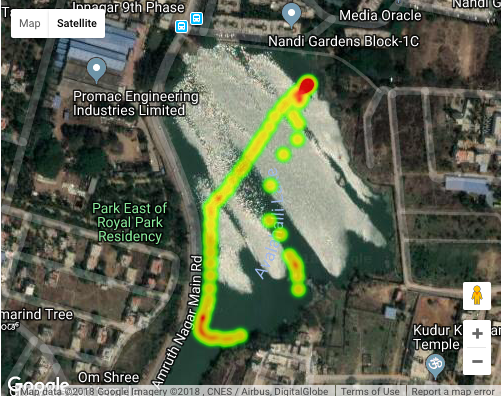Brilliant! School Kids Build World’s First ‘FLoBoT’ to Save Bengaluru’s Polluted Lakes
The problem of cleaning up the lakes to acquire drinking water, they discovered, did not just lie with tackling pollution but in the lack of awareness about the condition.

It was in 2016 when two tenth graders–Pranav Shikarpur and Siddharth Viswanath–decided to do something about the Kaveri dispute between Karnataka and Tamil Nadu.
Following their teacher’s instruction to learn about Bengaluru;s lakes, the two learnt about their deteriorating condition.
Once known as the city of lakes, the two youth were saddened at the extent of the water pollution. Speaking to The Better India, Pranav says, “In 1960, we had 262 lakes, but now we only have 81 lakes, of which only 32 are considered to be live.”
The problem of cleaning up the lakes to acquire drinking water, they discovered, did not just lie with tackling pollution but in the lack of awareness about the condition.
Decoding the source and extent of the pollution of each of the lakes is just as important as the aggregate process of cleaning them up. And studying water bodies of this number is no easy task.

For example, a survey conducted by the Environmental Management & Policy Research Institute (EMPRI) categorised over 1,518 water bodies in Bengaluru with over 65 attributes. They found that as many as 85% of the city’s water bodies were severely polluted.
A significant point to note is that the EMPRI study lasted two years! These surveys can take so long that the data recorded at the beginning could change entirely towards the end of the research period.
“Even the data from government samples isn’t easily available to the public,” Pranav points out.
So with that in mind, the students started working on a prototype that could easily analyse the constituents of the lake for better awareness.
Attention young innovators! India’s biggest youth innovation challenge is here. Atal Innovation Mission, NITI Aayog & The Better India present Innovation Marathon 2018 — a nation-wide challenge open to those under the age of 18 with innovations that can solve some of India’s most pressing issues.
Have an innovation?
Unable to view the above button? Click here
“We began with a breadboard prototype where it worked in a lake-like-scenario,” recalls Pranav.
They had showcased the prototype in a science fair, and the response was overwhelming. “We showed that our idea worked and with proper implementation, it could be resourceful,” he adds.
So they took to the drawing board, but this time, they had a helping hand from Dr T V Ramachandra, a Professor at the Indian Institute of Science, Bengaluru.
Dr Ramachandra is part of IISc’s Energy and Wetlands Research Group and has been at the forefront of decoding pollution in and around the erstwhile lake city through his participation in many research groups.
With his help, the students managed to build a full-fledged device and thus, the FLoBoT was born.
“FLoBoT 1.0 was a device we quickly put together, so it looked crude. In the middle was a buoy, with an electronic box on the top and the various sensors at the bottom,” Pranav explains.

He continues, “The best part about the 1.0 was that it could send SMS of the collected data to anyone and could also upload the information to the cloud. We also had a local app which could control the robot wirelessly.”
The FLoBoT was one the world’s first mobile data acquisition monitors that could be deployed in any water body to read out information such as electrical conductivity, dissolved oxygen, pH, and so on.
Despite all this, the FLoBoT 1.0 had its downfalls. “It was an unyielding device, weighing about 16 kgs,” the youngster adds.
Also, the device didn’t have its propellers, which meant that it had to be towed around the lake manually, with the help of a boat.
The students wanted to make a device that would have a leverage against the conventional means of testing, something that could be as consumer-friendly as possible. This would mean that the device would have to be smaller and even aesthetic.
The team raised about $3,500 through crowdfunding for an updated model and soon started to work on it. Their product designer, Kishore Babu, put together a beautiful design, which came to be known as FLoBot 2.0.

The major upgrade of the new version was its reduced weight of 6 kgs, a marked improvement over the previous 16 kgs. But the new device also had added thrusters, which would propel the device in the water once deployed. This design upgrade also meant that it could be transported easily.
With this, the team set out to test different lakes in Bengaluru. Previously, the 1.0 had tested about six lakes, while the 2.0 would go on to test eight.
“A new feature we could introduce was heat mapping,” says Pranav. “Until now, data like dissolved oxygen, dissolved solids, salinity etc. were available, but all this would be hard for the common man to read,” explains Pranav.
So, they took the information and changed it into a graphical representation, which is heat mapping. The team coupled the GPS data with the info collected and mapped it on Google Maps.
Here are heat maps generated by the FLoBoT 2.0 of some lakes.

TIME: 7:35AM-8:35AM . After entry of sewage

TIME: 8:10AM-8:45AM
Now this is where it gets ghastly.
The data shows that the pH levels of some lakes was as high as 9 and the dissolved oxygen as low as 0.79 mg/L, whereas most fish cannot even survive below 3 mg/L.
Pranav paints a picture of their first-hand experience with different lakes. He says, “We have seen Alahalli lake being polluted with blood from a nearby slaughterhouse, Kaggadasapura lake filled with froth, Puttenhalli lake had dead fish due to the inflow of sewage.”
The FLoBoT data was revealing an ugly side of the serene lakes.

Pranav says lake conservationists, who also helped them in their experiments, were doing their best but the contamination kept growing.But all may not be lost.
Organisations like ATREE have guided the team and have used FLoBoT in reviving lakes and water bodies that were once abandoned. Data like these, although harsh, helps in understand where one could start the process of cleaning the lakes.
For their innovation with the FLoBoT, the duo was selected for the Ashoka Youth Venture, where Pranav says, the venture helped them to harness particular skills that would promote them as changemakers.
The duo is very grateful to their physics teacher, Mr Manjunath SR who guided them, even though they were in the middle of their class 10 board exams. Moreover, Pranav’s father, Mr Uttam Shikarpur mentored them in tackling engineering obstacles.
Today, the team has created the organisation ‘Testing Waters’ dedicated to conserving water bodies. The duo also participated in the IRIS Science Fair in Delhi and got a chance to participate at “Intel ISEF in Pittsburgh” where they won the 2nd Grand Award.
Attention young innovators! India’s biggest youth innovation challenge is here. Atal Innovation Mission, NITI Aayog & The Better India present Innovation Marathon 2018 — a nation-wide challenge open to those under the age of 18 with innovations that can solve some of India’s most pressing issues.
Have an innovation?
Unable to view the above button? Click here
Presently, the device costs about $2,000, which is only 10% of other commercially available devices. The duo is now in the process of upgrading FLoBoT 2.0 in the hopes of making it more economically feasible.
Dedicated to bringing real-time monitoring of lakes to all citizens, Team Testing Waters is determined to create greater awareness among citizens and improve the quality of Bengaluru’s lakes.
Log on to the website for more information about the organisation or a look at their findings.
(Edited by Shruti Singhal)
Hey, you may also like: Locals Breathe Life Into Dying Bengaluru Lake, Clear Idol Debris Themselves
Like this story? Or have something to share?
Write to us: [email protected]
Connect with us on Facebook and Twitter.

Similar Story

Laundromats in India? Couple Built Rs 100 Crore Biz Washing Dirty Linen Across 100 Cities
Faridabad’s Arunabh Sinha and his wife Gunjan Taneja launched UClean in 2017 to set up an organised laundromat service in India. Currently, they are spread across 100+ cities and have 350+ outlets across the country.
Read more >
If you found our stories insightful, informative, or even just enjoyable, we invite you to consider making a voluntary payment to support the work we do at The Better India. Your contribution helps us continue producing quality content that educates, inspires, and drives positive change.
Choose one of the payment options below for your contribution-
By paying for the stories you value, you directly contribute to sustaining our efforts focused on making a difference in the world. Together, let's ensure that impactful stories continue to be told and shared, enriching lives and communities alike.
Thank you for your support. Here are some frequently asked questions you might find helpful to know why you are contributing?


This story made me
-
97
-
121
-
89
-
167












